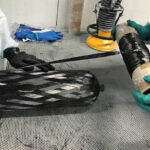Scientists from the Fraunhofer Institute for Structural Durability and System Reliability (LBF) and the Bundesanstalt für Materialforschung und prüfung (BAM) have announced to have found a process to develop flame retardant thermoplastic polyurethane (TPU) faster.
TPUs: a growing market
Nowadays, because of the increasing electrification of mobility and digitalisation of everyday objects there is a greater demand for specialised materials. Thermoplastic polyurethane (TPU) as a high-performance material, is among these future materials.
According to Fraunhofer Institute, the market for TPUs is valued at €1.5 billion, and experts expect an annual growth of 5.3% until 2025.
In addition to excellent qualities such as damping capacity, low-temperature flexibility, chemical stability and wear and abrasion resistance, these types of polymers also display thermal instability and light flammability, which makes the development of flame-retardant materials particularly demanding. At the same time, it is observed during the processing of TPU that a high shearing sensitivity results in a build-up of shear stress, which complicates a uniform dispersion of the flame retardant. The development of flame-retardant TPU formulations is therefore demanding and cost-intensive.
In order to support industry with these challenges, the researchers are proposing both accelerated procedures in processing and in the characterisation of fire behaviour.
A research for helping industry to develop TPUs faster
The researchers developed flame-retardant compounds with different formulations for three TPU base materials with different Shore hardness, in way to determine the material properties required. Flame retardants were added so that the influence on mechanical parameters would be changed as little as possible. The rapid mass calorimeter was tested as a fast method of fire behaviour analysis and all results were compared with the corresponding measurements in the cone calorimeter. The accompanying investigation involved pyrolysis using thermoanalytical methods, such as thermogravimetric analysis coupled with the Fourier-transform infrared spectrometer, pyrolysis gas analysis and pyrolysis gas chromatography with mass spectrometry coupling.
According to Fraunhofer, it was shown that the rapid mass calorimeter is suitable to evaluate the achieved flame retardance of any flame-retardant TPU. The different TPU types displayed only few, albeit significant differences, e.g. in the mass loss of the individual decomposition stages of pyrolysis and in the mechanics. Some formulations with nitrogen-based flame retardants showed mechanics in the pure material area. However, some proved to be surprisingly similar in terms of fire behaviour and flame retardancy.
This news uses material from Fraunhofer and Materials Today.












